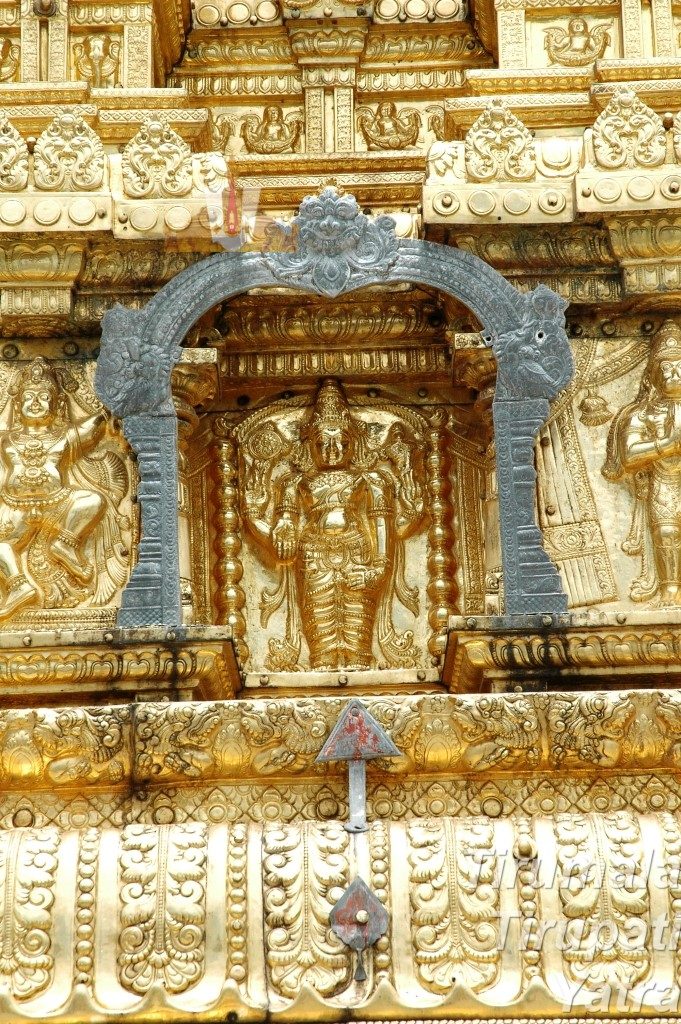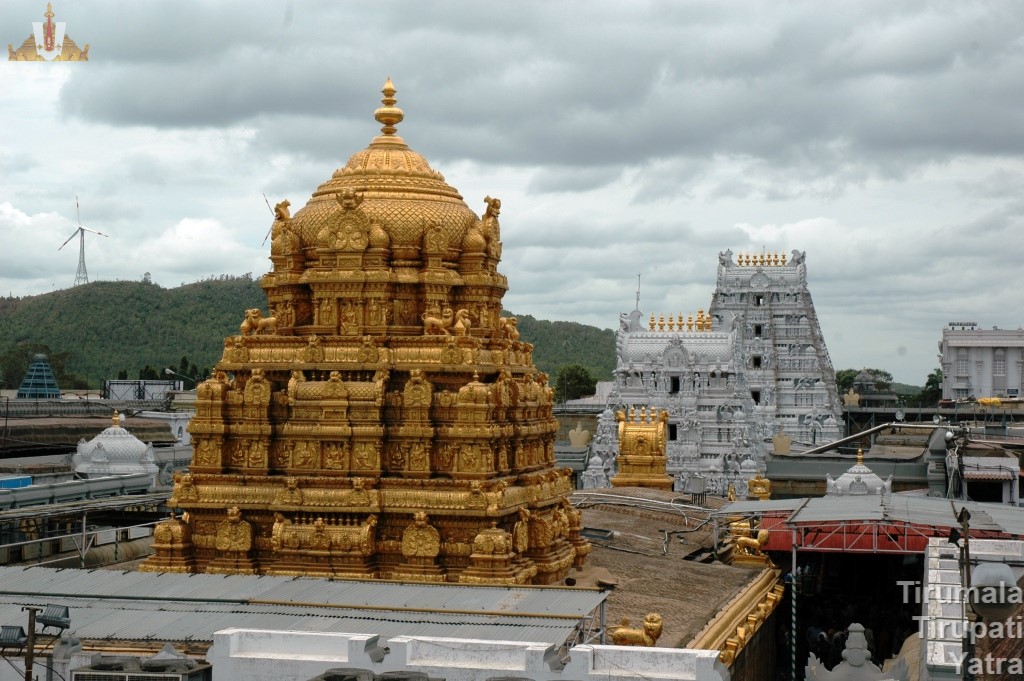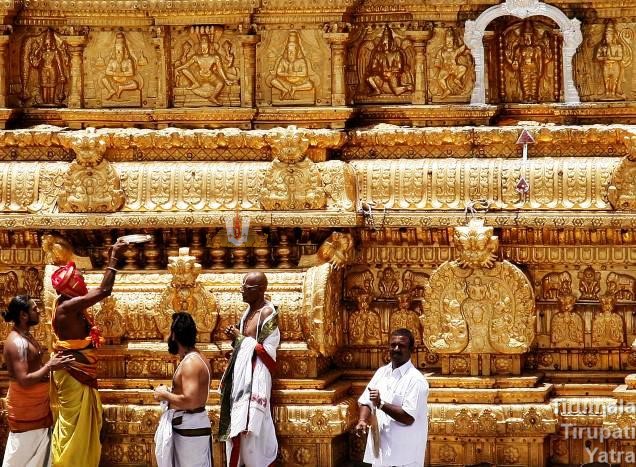Ananda Nilaya Vimana
The word “Vimana” means to house the lofty image of the Supreme being. In the word “Vimanam”, the alphabet ‘ma’ means an object which is measured or made in various ways. The prefix ‘vi’ denotes “vishesha” which signifies the image. So, the word itself, from its etymological aspects carries a noble and elevating significance.
Several Puranas have umpteen references to Vimana with different meanings.
But, in Tirumala, the second among the l08 divya desas, the Supreme being is stationed in the sanctum sanctorum called Ananda Nilaya Vimana. In Sri Padma Puranam, chapter 10, it is described that, the appearance of a new and unblemished Vimana which gladdens the hearts of the viewers, on the western side of the sacred tank.
It is said in Vamana Purana Chapter 40/21, there is an account of Brahma and other gods having obtained a view of the deity in the divine Vimana of this temple. On that occasion, Vishnu is said to have appeared to human beings as the image of Srinivasa in the Sanctum built by man.
Ananda Nilaya Vimana indicates the abode of Mulavirat of the sacred Seven Hills.

The Blissful Supreme
It is said that Thondaman Chakravarti, a great King of the Thondamandalam area ordered to build Lord Srinivasa Temple and a Vimana as described in Bhavishyothara Purana. Even in Tiruvenkata Puranam’s eleventh chapter, the same was told in Tamil.
In the Puranic age, it is said that Vamana Purana refers that on the banks of Swami Pushkarani, great sages headed by Agasthya along with King Sanaka, visualized the Lord when he manifested himself in his divine Ananda Nilaya Vimana, which was conical, studded with precious stones and decked with garlands of pearls.
In Vamana Purana, Agastya says that in the Kali age which was yet to come, a holy Vimana will destroy all sins of viewers, which by its auspicious nature will gladden the hearts of all viewers, which will be worshipped by celestial beings, gandharvas etc., which will have unique good features, in which the Lord will be ever resident, is going to be designed and constructed by the devotees of Vishnu.
The Vimana was directly transported from the world of Bliss i.e. Sri Vaikunta.
It is also the abode of Ananda – the blissful Supreme being in archa form, the Vimana over the abode of Sri Srinivasa was named Ananda Nilaya Vimana. Even in the Ashtotharam of Sri Venkateswara, it is said :
Om Vaikuntaagatha Sadhema vimaana antargataaya Namaha!!
It is also said that Vimana was created by the Supreme being Himself out of his own Maya as stated: Om Maayaa gooda Vimaanaaya Namaha!!
According to the most authentic source of Tirumala rituals, Tirumalai Ozhugu, in one of the 3 visits of Sriman Ramanuja set aside the disputes about “Who the God is?” and confirmed with indisputable facts that the Lord on Seven Hills is Lord Narayana only.
During that time Sriman Ramanuja consecrated the deity by adorning Mulavirat with Conch and Discus and performed a full-scale Samprokshanam as per the rules of Vaikhanasa Agama by installing the images of Varaha, Narasimha, Vaikuntanatha and Srinivasa on four sides of the Vimana.
In Tirumala, Lord Narasimha is housed in the north of Swami Pushkarani. Intending to reduce his fierceness, Sriman Ramanuja shifted the deity from that place to the northeast of Ananda Nilaya Vimana and established him facing the Vimana.
Great Art
The significance of Vimana is that it is a three-storeyed Vimana constructed to the maximum height. The square base is 27’4″ and the height is 37’8″, which includes Kalasa over the present terrace of sanctum sanctorum.
The first two tiers are rectangular and the third is circular in plan. There are no figures sculpted in the first tier. There are forty figures in the second and the third or topmost story is placed with good space left out at the four corners.
During the Samprokshanam, two lions with a lotus in between them were installed. It is said that about 12 tons of copper and 12000 tolas of gold were used in the construction of the Kavacham for the Ananda Nilayam. It is said that the outstanding feature of the Vimana is a blend of traditional design and artistic skill, modern techniques of manufacture and finishing, not to speak of elaborate attention paid to every small detail of the work.

It will be of great interest to know from the TTD inscriptions about the growth and development of Ananda Nilaya Vimana, since Pandya King. It is said that Sundara Pandya was the first to make a gold Kalasa and fixed it in 1262 A.D.. Vira Narasimha of Vijayanagara King performed his Tulabhara ceremony and presented the gold to the temple for guiding the Vimana and other structures.
Renovations
- Saluva Mangideva, a general under Kumara Kampana Udaiyar, fixed a golden Sikhara on the Vimana in 1359 A.D..
- Amatyasekhara Mallana, a Minister under Devaraya-II in 1417 A.D. renovated Ananda Nilaya Vimana.
- In 1518, Sri Krishnadevaraya, Vijayanagara King, during his fifth visit presented 30,000 gold varahas for guilding of the Vimana.
- Again in 1630 A.D. Kotikanyakadanam Taachariar of Kancheepuram, arranged gold guilding of the Vimana.
- Later in 1908, Adhikari Ramalakshmanadasa, one of the brother disciples of Sri Mahant Prayagdasa fixed gold Kalasa over the Vimana. Thus, Ananda Nilaya Vimana was covered with gold gilted plates in different times.
Krite Varadarajastu Tretayam Ranganayakah!
Dwapare Tu Jagannathah Kalov Venkatanayakah!!
Data source: Article posted by Dr. M. Varadarajan

